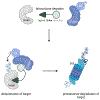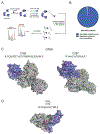Ligandability of E3 Ligases for Targeted Protein Degradation Applications
- PMID: 34473924
- PMCID: PMC8928483
- DOI: 10.1021/acs.biochem.1c00464
Ligandability of E3 Ligases for Targeted Protein Degradation Applications
Abstract
Targeted protein degradation (TPD) using proteolysis targeting chimeras (PROTACs) and molecular glue degraders has arisen as a powerful therapeutic modality for eliminating disease-causing proteins from cells. PROTACs and molecular glue degraders employ heterobifunctional or monovalent small molecules, respectively, to chemically induce the proximity of target proteins with E3 ubiquitin ligases to ubiquitinate and degrade specific proteins via the proteasome. Whereas TPD is an attractive therapeutic strategy for expanding the druggable proteome, only a relatively small number of E3 ligases out of the >600 E3 ligases encoded by the human genome have been exploited by small molecules for TPD applications. Here we review the existing E3 ligases that have thus far been successfully exploited for TPD and discuss chemoproteomics-enabled covalent screening strategies for discovering new E3 ligase recruiters. We also provide a chemoproteomic map of reactive cysteines within hundreds of E3 ligases that may represent potential ligandable sites that can be pharmacologically interrogated to uncover additional E3 ligase recruiters.
Conflict of interest statement
Competing Financial Interests Statement
DKN is a co-founder, shareholder, and adviser for Frontier Medicines.
Figures



References
Publication types
MeSH terms
Substances
Grants and funding
LinkOut - more resources
Full Text Sources
Other Literature Sources
Molecular Biology Databases

